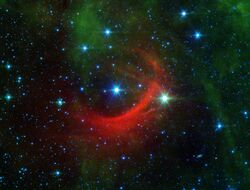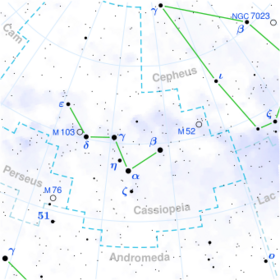Astronomy:Kappa Cassiopeiae
| Observation data Equinox J2000.0]] (ICRS) | |
|---|---|
| Constellation | Cassiopeia |
| Right ascension | 00h 32m 59.991s[1] |
| Declination | +62° 55′ 54.42″[1] |
| Apparent magnitude (V) | 4.12 - 4.21[2] |
| Characteristics | |
| Spectral type | BC0.7 Ia[3] |
| Apparent magnitude (U) | 3.50[4] |
| Apparent magnitude (B) | 4.276[4] |
| Apparent magnitude (J) | 4.141[4] |
| Apparent magnitude (H) | 4.148[4] |
| Apparent magnitude (K) | 4.013[4] |
| U−B color index | −0.776[4] |
| B−V color index | +0.0869[4] |
| J−H color index | −0.0069[4] |
| J−K color index | +0.128[4] |
| Variable type | α Cyg[5] |
| Astrometry | |
| Radial velocity (Rv) | 0.30[6] km/s |
| Proper motion (μ) | RA: +3.65[1] mas/yr Dec.: −2.07[1] mas/yr |
| Parallax (π) | 0.73 ± 0.17[1] mas |
| Distance | approx. 4,000 ly (approx. 1,400 pc) |
| Absolute magnitude (MV) | −7.1[7] |
| Details | |
| Mass | 33[8] M☉ |
| Radius | 39[7] R☉ |
| Luminosity | 490,000[7] L☉ |
| Surface gravity (log g) | 2.79[7] cgs |
| Temperature | 24,600[7] K |
| Rotational velocity (v sin i) | 58[7] km/s |
| Age | 4.5[9] Myr |
| Other designations | |
| Database references | |
| SIMBAD | data |

Kappa Cassiopeiae (κ Cas, κ Cassiopeiae) is a star in the constellation Cassiopeia.
κ Cassiopeiae has an unusual spectrum that has anomalously weak nitrogen lines, taken as an actual nitrogen deficiency in the atmosphere. This is indicated by the modified letter C on the assumption that it is also carbon-rich, although this might not actually be the case.[8] It is also interpolated to BC0.7, being slightly hotter than a standard B1 star.[10][11]
κ Cassiopeiae is assumed to be a member of the Cassiopeia OB14 stellar association (Cas OB14) and treated as being at a distance of about 1,100 pc,[11] while its distance found from the Hipparcos parallax is about 1,400 parsecs.[1] Its Gaia parallaxes are somewhat uncertain due to the brightness of the star, but a modern determination of the distance to Cas OB14 is 880 pc.[12]
It is classified as an Alpha Cygni type variable star and its brightness varies by a few hundredths of a magnitude. Periods of two hours,[14] 2.65 days,[15] and nine days[16] have been reported from observations at different times.
It is a runaway star, moving at around 2.5 million mph relative to its neighbors (1,100 kilometers per second). Its magnetic field and wind of particles creates a visible bow shock 4 light-years ahead of it, colliding with the diffuse, and usually invisible, interstellar gas and dust. This is about the same distance that Earth is from Proxima Centauri, the nearest star to the Sun.[17] The dimensions of the bow shock are vast: around 12 light-years long and 1.8 light-years wide.[18]
References
- ↑ 1.0 1.1 1.2 1.3 1.4 1.5 van Leeuwen, F. (2007). "Validation of the new Hipparcos reduction". Astronomy and Astrophysics 474 (2): 653–664. doi:10.1051/0004-6361:20078357. Bibcode: 2007A&A...474..653V.Vizier catalog entry
- ↑ "kappa Cas". AAVSO. https://www.aavso.org/vsx/index.php?view=detail.top&oid=7293.
- ↑ Kraus, M.; Borges Fernandes, M.; Kubát, J. (2009). "Parameters of galactic early B supergiants. The influence of the wind on the interstellar extinction determination". Astronomy and Astrophysics 499: 291. doi:10.1051/0004-6361/200810319. Bibcode: 2009A&A...499..291K.
- ↑ 4.0 4.1 4.2 4.3 4.4 4.5 4.6 4.7 4.8 Ducati, J. R. (2002). "VizieR Online Data Catalog: Catalogue of Stellar Photometry in Johnson's 11-color system". CDS/ADC Collection of Electronic Catalogues 2237. Bibcode: 2002yCat.2237....0D.
- ↑ Samus, N. N. et al. (2009). "VizieR Online Data Catalog: General Catalogue of Variable Stars (Samus+ 2007-2013)". VizieR On-line Data Catalog: B/GCVS. Originally Published in: 2009yCat....102025S 1. Bibcode: 2009yCat....102025S.
- ↑ Gontcharov, G. A. (2006). "Pulkovo Compilation of Radial Velocities for 35 495 Hipparcos stars in a common system". Astronomy Letters 32 (11): 759–771. doi:10.1134/S1063773706110065. Bibcode: 2006AstL...32..759G.
- ↑ 7.0 7.1 7.2 7.3 7.4 7.5 Simón-Díaz, S.; Aerts, C.; Urbaneja, M. A.; Camacho, I.; Antoci, V.; Fredslund Andersen, M.; Grundahl, F.; Pallé, P. L. (2018). "Low-frequency photospheric and wind variability in the early-B supergiant HD 2905". Astronomy and Astrophysics 612: A40. doi:10.1051/0004-6361/201732160. Bibcode: 2018A&A...612A..40S.
- ↑ 8.0 8.1 Searle, S. C.; Prinja, R. K.; Massa, D.; Ryans, R. (2008). "Quantitative studies of the optical and UV spectra of Galactic early B supergiants. I. Fundamental parameters". Astronomy and Astrophysics 481 (3): 777. doi:10.1051/0004-6361:20077125. Bibcode: 2008A&A...481..777S.
- ↑ Tetzlaff, N.; Neuhäuser, R.; Hohle, M. M. (January 2011). "A catalogue of young runaway Hipparcos stars within 3 kpc from the Sun". Monthly Notices of the Royal Astronomical Society 410 (1): 190–200. doi:10.1111/j.1365-2966.2010.17434.x. Bibcode: 2011MNRAS.410..190T.
- ↑ Walborn, Nolan R. (1971). "Some Spectroscopic Characteristics of the OB Stars: An Investigation of the Space Distribution of Certain OB Stars and the Reference Frame of the Classification". Astrophysical Journal Supplement 23: 257. doi:10.1086/190239. Bibcode: 1971ApJS...23..257W.
- ↑ 11.0 11.1 Walborn, Nolan R. (1971). "On the Existence of OB Stars with Anomalous Nitrogen and Carbon Spectra". Astrophysical Journal 164: L67. doi:10.1086/180693. Bibcode: 1971ApJ...164L..67W.
- ↑ Melnik, A. M.; Dambis, A. K. (April 2020). "Internal motions in OB associations with Gaia DR2". Monthly Notices of the Royal Astronomical Society 493 (2): 2339–2351. doi:10.1093/mnras/staa454. Bibcode: 2020MNRAS.493.2339M.
- ↑ "Light Curve". ESA. https://www.cosmos.esa.int/web/hipparcos/java-tools/light-curve.
- ↑ Elst, E. W. (1979). "Spectroscopic and Photometric Variation of kappa Cas". Information Bulletin on Variable Stars 1697: 1. Bibcode: 1979IBVS.1697....1E.
- ↑ Koen, Chris; Eyer, Laurent (2002). "New periodic variables from the Hipparcos epoch photometry". Monthly Notices of the Royal Astronomical Society 331: 45–59. doi:10.1046/j.1365-8711.2002.05150.x. Bibcode: 2002MNRAS.331...45K.
- ↑ Percy, J. R. (1981). "Photometric Variability of kappa Cassiopeiae". Information Bulletin on Variable Stars 1946: 1. Bibcode: 1981IBVS.1946....1P.
- ↑ Clavin, Whitney (21 February 2014). "The bow shock of Kappa Cassiopeiae, a massive, hot supergiant". Phys.org. http://phys.org/news/2014-02-kappa-cassiopeiae-massive-hot-supergiant.html.
- ↑ Peri, C. S.; Benaglia, P.; Brookes, D. P.; Stevens, I. R.; Isequilla, N. L. (2012). "E-BOSS: An Extensive stellar BOw Shock Survey. I. Methods and first catalogue". Astronomy & Astrophysics 538: A108. doi:10.1051/0004-6361/201118116. Bibcode: 2012A&A...538A.108P.
 |



